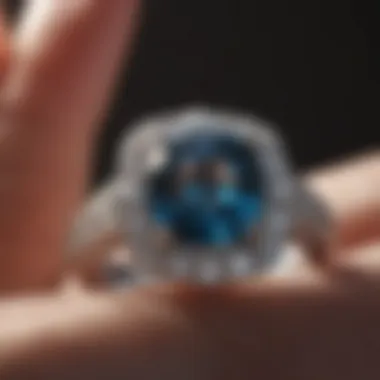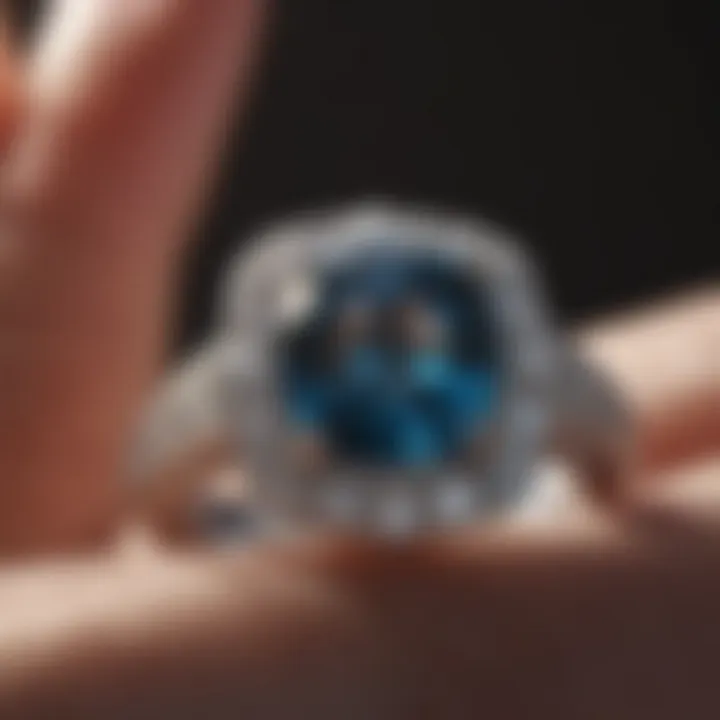Mastering the Art of Selling an Engagement Ring


Intro
Selling an engagement ring can be more complicated than many anticipate. A seller faces multiple considerations that extend beyond simple monetary exchange. Understanding the nuances involved is vital for successful transactions. This article delves into the various factors that influence the selling process, providing insights that cater to both novice and experienced sellers. By examining aspects such as valuation, market trends, emotional dimensions, and strategic tips, sellers will equip themselves with the knowledge necessary to navigate this intricate landscape.
Gemstone Overview
Definition of Gemstones
Gemstones are naturally occurring crystals that are valued for their beauty and rarity. They are often cut and polished to enhance their appearance. The allure of gemstones is not solely in their physical attributes but also in the symbolic meanings and emotional connections they hold.
Classification of Gemstones
There are two main categories of gemstones: precious and semi-precious. Precious gemstones include diamonds, rubies, sapphires, and emeralds. These are typically more valuable due to their scarcity and desirability. Semi-precious gemstones, such as amethyst and opal, are more abundant but still possess distinct characteristics that can appeal to buyers.
Each gemstone has unique traits, such as color, clarity, cut, and carat weight, which play significant roles in their valuation. Understanding these factors is crucial when selling an engagement ring.
Historical Significance
Origins of Gemstone Use
The use of gemstones dates back thousands of years. In ancient cultures, they were often associated with power, protection, and spirituality. Historical records reveal that gemstones adorned royalty and were used in religious artifacts.
Cultural Insights: Gemstones in Ancient Civilizations
In ancient Egypt, for instance, turquoise was highly prized and often used in burial masks. Similarly, the Romans believed in the protective qualities of certain stones, like amethyst. Each civilization had its own interpretations and uses for gemstones, highlighting their universal significance across cultures.
"Gemstones are not just beautiful; they carry histories that span centuries, connecting individuals to traditions and beliefs."
Prelims
Selling an engagement ring is not merely a transaction; it is an intricate process fraught with emotional, financial, and regulatory considerations. Engagement rings often symbolize profound commitments, making the decision to sell them a significant emotional endeavor. Understanding the complexities involved can aid sellers in navigating potential challenges and maximizing the value of their piece.
Moreover, being informed about market trends elevate the selling experience. Sellers need awareness of how demand fluctuates, the impact of current styles, and how these factors can influence their sale. By grasping the various aspects at play, including valuation criteria and emotional attachments, sellers position themselves to make better decisions.
In this guide, we delve into numerous themes relevant to selling engagement rings. We will explore valuing the ring efficiently, cleaning and presenting it properly, and determining the best venues for sale. By gathering the right knowledge, sellers can embark on this journey with clarity and confidence. This understanding is essential not only for achieving favorable financial outcomes but also for addressing the emotional ramifications that accompany selling a cherished item.
Understanding the Market for Engagement Rings
The market for engagement rings is intricate and ever-evolving. Understanding its dynamics is essential for anyone looking to sell an engagement ring. This knowledge can guide sellers through various considerations, allowing them to make informed decisions that can lead to successful transactions. Factors such as current market trends, consumer preferences, and cultural influences all play a role in shaping the market landscape. By being aware of these elements, sellers gain the advantage of positioning their rings effectively. In this way, they can maximize their returns and connect with potential buyers who are looking for specific characteristics in an engagement ring.
Current Market Trends
In recent years, the engagement ring market has seen significant changes. Awareness around ethical sourcing has increased. Many buyers prioritize rings made from conflict-free diamonds or lab-created stones. As a result, sellers should determine the origins of their stones and highlight ethical aspects when marketing their rings. Another trend is the preference for unique, custom designs over traditional styles. Today, consumers are more inclined to seek something that stands out.
Moreover, the availability of information online has given buyers greater power. They can easily compare prices and styles across various platforms. Sellers need to understand these dynamics when pricing their rings. Keeping abreast of current trends can help sellers adjust their strategies effectively.
"Being informed about market trends can significantly influence the selling process. It allows sellers to anticipate buyer behavior and preferences."
Demand for Vintage vs. New Rings
The demand for vintage rings often contrasts with that for new ones. Vintage rings carry a sense of history and uniqueness that many buyers find appealing. These pieces often possess distinctive craftsmanship not frequently seen in modern designs. Many buyers are also drawn to the stories behind vintage rings, increasing their desirability.
On the other hand, new rings are popular for buyers who prefer contemporary styles and modern techniques. They may also favor the assurance of purchasing something that is not associated with past relationships or sentiments.
When considering selling an engagement ring, it's crucial to understand the particular demand in the market. Knowing whether a vintage or new ring is likely to sell more can influence your approach. Sellers should evaluate the specific characteristics of their ring and decide how best to market it based on prevailing consumer preferences.
Determining the Value of an Engagement Ring
Understanding how to determine the value of an engagement ring is crucial for a successful selling process. Proper assessment influences how much you can expect to gain from your sale. This section will clarify the key factors that affect the ring's value, providing practical guidance for sellers.
Factors Influencing Value


Determining a ring's worth requires a focus on several significant factors. Each component contributes uniquely to the overall valuation.
Gemstone Quality
When assessing an engagement ring, the gemstone quality means everything. The four Cs—carat, cut, color, and clarity—play a critical role in identifying its worth.
- Carat refers to the size of the gemstone. Larger stones typically command higher prices.
- Cut influences how well the stone reflects light. A well-cut diamond appears more brilliant.
- Color pertains to the presence of tints in the gemstone. For diamonds, less color often equates to higher value.
- Clarity indicates the presence of internal or external flaws. Fewer flaws mean greater value.
High-quality gemstones are popular choices for buyers. Their unique feature is the ability to enhance aesthetic appeal and durability. However, poor-quality stones can detract from the ring's overall value and desirability.
Metal Type
The metal type encompasses the material used in the band and setting. Common metals like platinum, gold, and white gold differ significantly in value and appeal.
- Platinum is known for its strength and longevity, making it a premium choice but also more costly.
- Gold comes in several colors, including yellow and rose, with varying purities. Higher karat gold (like 18K) is generally more valuable.
- White gold offers a modern look with a lower price compared to platinum but may require rhodium plating for aesthetic purposes.
The unique feature of metal type is its scrap value. Some buyers might appreciate a valuable metal, regardless of the ring's design. However, certain metals might be less desirable depending on market trends.
Brand Reputation
Brand reputation is another component that can substantially influence a ring's value. Rings from reputable brands like Tiffany & Co. or Cartier often achieve higher resale prices due to perceived quality and prestige.
- A well-known brand provides assurance of craftsmanship and materials used.
- Desirability plays a significant role in determining how buyers perceive value. Established brands typically retain their value better than lesser-known ones.
The unique feature of brand reputation lies in its ability to enhance emotional appeal. Buyers often connect with the brand image, affecting their willingness to pay. However, not all branded rings automatically translate to high value, especially if they are not in demand.
Professional Appraisal
Lastly, a professional appraisal serves as a valuable step in determining the value of an engagement ring. An expert evaluates all contributing factors, offering an unbiased assessment. Appraisals can add credibility to the sale, giving potential buyers confidence in their purchase. It's often recommended to obtain multiple appraisals to ensure fairness. Documenting these appraisals can prove advantageous during negotiations.
"A knowledgeable appraisal can be the difference between an effective sale and a regrettable loss."
Preparing for the Sale
Preparing for the sale of an engagement ring is a critical step that can significantly influence the outcome of the transaction. This phase involves several essential elements that not only help maximize the value of the ring but also create a smoother selling process. First, attention to presentation can elevate buyer interest and create a favorable impression. Clean and well-maintained rings are more attractive to potential buyers. Furthermore, gathering proper documentation can add legitimacy to the sale and assurance to the buyer regarding the ring's quality and authenticity. Thus, preparation is not merely about cleaning the ring or presenting it well; it is about presenting a comprehensive, trustworthy package that taps into the buyers’ confidence.
Cleaning and Presentation
A cleaned engagement ring presents itself in the best possible light. Dirt and grime can obscure the ring’s true beauty and charm. Potential buyers might view a dirty ring as a sign of neglect, which can negatively affect their perception of its value. Proper cleaning restores shine and clarity to the gemstones and metal, allowing the intricate details to stand out. Sellers may consider using professional cleaning services or high-quality cleaners designed for jewelry. When displaying the ring for sale, consider a simple but elegant presentation box. The overall package can enhance desirability and perceived value.
Gathering Documentation
Proper documentation is crucial in establishing a credible selling process. Two key types of documents play essential roles: certification papers and purchase receipts.
Certification Papers
Certification papers are crucial as they validate the quality and authenticity of the gemstones. Gemological certificates typically provide details on the diamond’s carat weight, cut, color, and clarity. This level of detailed information helps buyers make informed decisions, as they can trust the data presented. Moreover, having certification enhances the ring's selling price, as buyers are more inclined to pay a premium for verifiable quality. However, it’s essential to ensure that these papers are from reputable gemological laboratories, as the authenticity of these documents plays a significant role in buyer trust.
Purchase Receipts
Purchase receipts prove the origin of the engagement ring. These documents detail the ring's initial value and ensure the buyer of its legal ownership and provenance. Such information can increase buyer confidence, as it traces the ring’s journey back to a legitimate source. Furthermore, having a receipt can help in establishing a new price during resale; it serves as a reference point for negotiation. However, some sellers might find it challenging to locate original receipts, especially if the item was purchased long ago. In this case, sellers should rely on documentation, such as appraisals, instead.
Collectively, both certification papers and purchase receipts form a solid basis for a well-rounded sale process. They offer potential buyers reassurance about the quality and legitimacy of the engagement ring, thus increasing their willingness to proceed with a purchase.
Where to Sell an Engagement Ring
Determining where to sell an engagement ring is a crucial step in the selling process. Sellers must thoughtfully consider their options because each venue has unique advantages and potential drawbacks. Selecting the appropriate platform can significantly impact the speed of sale and the final price received. Understanding where to sell provides clarity and helps in making an informed decision.
Jewelry Stores
Jewelry stores represent a traditional route for selling engagement rings. Many shops will purchase used jewelry, often offering immediate payment. This allows sellers to quickly convert their asset into cash.


However, jewelry stores may also have specific criteria for purchasing items. They typically assess the ring's condition, quality, and desirability in the current market.
A few points to consider when selling to jewelry stores:
- Convenience: Selling to a store is relatively straightforward. You can bring the ring in, and many stores provide quick evaluations.
- Trustworthiness: Established jewelry stores often offer a level of credibility, which can be reassuring for sellers.
- Potential Lower Offers: While easy, the offers from jewelry stores can be lower than other selling methods due to their need to resell the ring at a profit.
Online Platforms
In recent years, online platforms have gained popularity for selling engagement rings. Websites like eBay, Etsy, or specialized jewelry resale sites allow sellers to reach a broad audience. The key to selling through these platforms is to present the ring effectively.
Selling online can offer several distinct advantages:
- Wide Audience: The internet connects you to potential buyers worldwide. This can lead to higher bids or faster sales.
- Control Over Pricing: Sellers have the ability to set their own prices and negotiate with buyers directly.
- Marketplace Options: Dedicated platforms often attract serious buyers looking specifically for used jewelry.
However, there are challenges in selling online:
- Shipping Concerns: Sellers need to navigate shipping and insurance to ensure the ring arrives safely.
- Scams and Safety: Online transactions can bring risks, including potential scams. Sellers must employ caution and verify buyer reputations.
Auction Houses
Auction houses provide another option for selling engagement rings, especially for unique or high-value pieces. They typically hold special jewelry auctions that can attract collectors and serious buyers.
Here are some important aspects of selling through auction houses:
- Expert Assessment: Auction houses often have experts who can appraise the ring and leverage their reputation to drive bids during the event.
- Targeted Audience: Selling through an auction allows access to an interested market that is specifically looking for unique pieces.
- Fees and Commissions: Sellers should be aware of fees taken by auction houses, which can affect final earnings from the sale.
Each selling avenue holds value but also demands due diligence from the seller. It is important to weigh the pros and cons and align them with personal goals regarding speed, price, and selling effort.
Making the right choice about where to sell not only aids in achieving the best price but also ensures a smoother selling experience.
Strategies for Effective Selling
Selling an engagement ring requires a strategic approach. Understanding the market and your emotional connection to the ring is crucial. Strategies that focus on timing and pricing can differentiate between a successful sale and a prolonged struggle. This section explores how to optimize these two critical elements for a successful transaction.
Timing Your Sale
Timing can significantly affect the sale of an engagement ring. Market conditions fluctuate, and certain times of the year may yield better prices or more interested buyers. For example, engagement rings are often more sought after around holidays and wedding seasons.
- Seasonality: Peak seasons, like Christmas or Valentine’s Day, see an increase in demand. If you can wait until these times, you might find a buyer faster.
- Local Market Conditions: It helps to keep an eye on the local market. An economic upturn may encourage buyers to spend more, whereas downturns might necessitate lower prices.
- Personal Timing: Your emotional readiness matters too. It's wise to sell when you feel detached from the ring. Emotional motivations can cloud judgment and lead to poor selling decisions.
In summary, understanding when to sell can maximize the potential value of your engagement ring.
Setting a Realistic Price
Establishing a price is one of the most critical factors in selling any item, particularly an engagement ring. A price too high may deter buyers, while too low might result in loss of potential value. Here are key components to consider when setting a price:
- Comparable Sales: Research similar rings that have sold recently. Look at platforms such as eBay or jewelry stores to gauge what similar rings fetch.
- Appraised Value: Getting a professional appraisal can provide a solid foundation for your asking price, based on the ring’s materials and craftsmanship.
- Negotiation Flexibility: Decide beforehand how much you are willing to negotiate. If you set a price with a little wiggle room, potential buyers may feel they are getting a deal, encouraging them to buy.
Ultimately, finding the sweet spot for pricing ensures the engageent ring sells quickly while still providing you with a fair return.
Understanding the Emotional Aspects
Selling an engagement ring is not merely a transaction; it involves significant emotional considerations. Understanding these emotional aspects can help a seller navigate the complex feelings tied to the ring and make choices that are both financially sound and personally satisfying. For many, an engagement ring symbolizes love and commitment. Therefore, parting with it can evoke feelings of loss and nostalgia. By recognizing these emotions, sellers can approach the sale with a clearer mindset.
Furthermore, acknowledging the emotional weight can guide sellers in how they present the ring to potential buyers. This aspect is crucial as it can influence the buyer's perception and ultimately the sale's success. Consideration of emotional factors assists sellers in forming authentic connections with buyers, potentially enhancing the value of the ring beyond its material worth.
Navigating Sentimental Attachments
Sentimental attachments to an engagement ring often complicate the decision to sell. Each ring carries its own story, reflecting personal memories and feelings. Dealing with these ties is an essential step before putting the ring on the market. Sellers might find value in reframing their perspective. Rather than viewing the ring as a symbol of the past, it can be seen as a means to future opportunities.
One strategy is to reflect on why selling is necessary. Is it for financial reasons or to move on emotionally? Understanding this can help clarify the motivation. It is also beneficial to document the memories associated with the ring. Writing these down may help ease the emotional burden and make it easier to let go.


!> "Sentimental attachments can make selling difficult, but reframing the narrative can aid in the decision-making process."
Additionally, when interacting with potential buyers, mentioning the ring's sentimental journey can engage them. Emotional connections can enhance the perceived value of the item, making it more appealing. Sellers should balance honesty about emotional ties with practicality, ensuring buyers see both the financial and personal worth of the ring.
Communicating with Potential Buyers
Effective communication with potential buyers is vital in selling an engagement ring. Clear and sincere communication not only fosters trust but can also impact the selling price. Sellers should articulate the features of the ring, such as the quality of the gemstone, the type of metal, and any unique characteristics it holds.
Taking time to understand the buyer's perspective is equally important. What are they looking for? Understanding their needs can inform how sellers present the ring. Providing answers to common questions helps build confidence in the purchase. Often, buyers appreciate background stories about the ring, which adds a layer of openness.
Creating a welcoming environment during discussions can facilitate better communication. Using forums such as Facebook or Reddit can provide spaces for sellers to engage with potential buyers. In these settings, sharing images and details about the ring can draw interest and influence conversations positively.
In summary, navigating the emotional aspects and communicating effectively with potential buyers is essential. By doing so, sellers can increase their chances of a successful sale.
Legal Considerations
Engaging in the process of selling an engagement ring involves navigating a landscape of legal considerations that can significantly influence the transaction. Understanding these legal elements not only safeguards the seller's interests but also helps build trust with potential buyers. Legal considerations can impact the sale's success by ensuring compliance with laws and regulations, thereby preventing future disputes or complications.
Disclosure Requirements
In the context of selling jewelry, particularly an engagement ring, disclosure requirements are critical. Sellers are often obligated to provide truthful information regarding the ring's characteristics. This includes details about the gemstone's authenticity, the quality of the materials used, and any previous repairs or treatments the item may have undergone.
"Providing accurate information is essential for establishing credibility and ensuring a smooth transaction."
Failure to disclose significant facts about the engagement ring may lead to legal repercussions, including potential lawsuits from the buyer. Therefore, it is advisable for sellers to prepare a clear statement of the engagement ring's features, supported by appropriate documentation, such as certification from reputable gemological laboratories.
Consumer Protection Laws
Consumer protection laws exist to shield buyers from unfair practices and to promote transparency in transactions. When selling an engagement ring, understanding these laws is paramount. These regulations vary by jurisdiction but generally include provisions that require sellers to act in good faith and offer clear descriptions of the item being sold. Additionally, these laws often allow consumers the right to return items under specific circumstances, which sellers must respect.
Being aware of and compliant with consumer protection laws not only minimizes risks of fraudulent claims but also enhances the seller's reputation in the market. Sellers should familiarize themselves with local laws and consider consulting with legal professionals to ensure they adhere to the rules governing jewelry sales. This proactive approach not only leads to legal safety but can also improve buyer confidence during the sale process.
Post-Sale Considerations
Understanding post-sale considerations is essential for anyone looking to sell an engagement ring. This stage involves not just the conclusion of a sale, but also the aftermath of that transaction. Sellers must recognize that even when the ring is no longer in their possession, there are several crucial matters to address.
First, sellers need to manage their expectations regarding the sale proceeds. It is important to understand that the market value of a ring does not always align with the actual sale price. Emotional value often results in sellers hoping for a greater return than what the market can offer. Recognizing this disparity can prevent disappointment and lead to more realistic financial planning.
Moreover, another significant aspect involves the financial implications tied to the sale. This includes aspects such as taxes on capital gains if applicable, transaction fees for platforms used, and possible costs associated with shipping or insuring jewelry during the sale process. Thus, before selling, it is prudent to consult with a financial advisor or accountant to clarify these factors. This preliminary work can smooth the transition from ownership to the sale and ultimately safeguard against unforeseen complications down the line.
Overall, navigating the post-sale landscape requires an awareness of emotional satisfaction, realistic expectations regarding the sale price, and a thorough understanding of financial responsibilities and implications following the sale.
The End
Selling an engagement ring is not merely a transaction; it encapsulates a range of complexities and considerations that require thoughtful attention. The conclusion of this article serves as a pivotal point, tying together the various elements discussed throughout. It underscores the significance of understanding market trends, valuation, emotional aspects, legal considerations, and post-sale implications. Each of these components plays a crucial role in ensuring that sellers navigate this sensitive process with clarity and confidence.
Importance of Market Insights
Market insights help potential sellers gauge the current landscape. Awareness of demand, particularly for vintage versus new rings, can inform a seller's strategy and expectations.
Valuation Relevance
Determining the value of an engagement ring is essential. Professional appraisals provide an objective standpoint, allowing sellers to set realistic pricing without succumbing to emotional biases.
Emotional Factors
Navigating sentimental attachments is often one of the most challenging aspects of the sale. Understanding these emotional complexities can help sellers communicate effectively with potential buyers, ensuring they present their ring in a manner that acknowledges its history while making it appealing for resale.
Legal Obligations
Being aware of legal considerations is also paramount. Disclosure requirements and consumer protection laws guide sellers in conducting a fair and transparent transaction. This not only builds trust with buyers but also protects the interests of the seller in any potential disputes.
Managing Expectations
Finally, post-sale considerations highlight the need for managing expectations. Understanding the financial implications of the sale can aid sellers in making informed financial decisions moving forward. By grasping these details, sellers can align their actions with their goals.
"Selling an engagement ring is an intricate process, entwined with market dynamics and personal sentiments."



